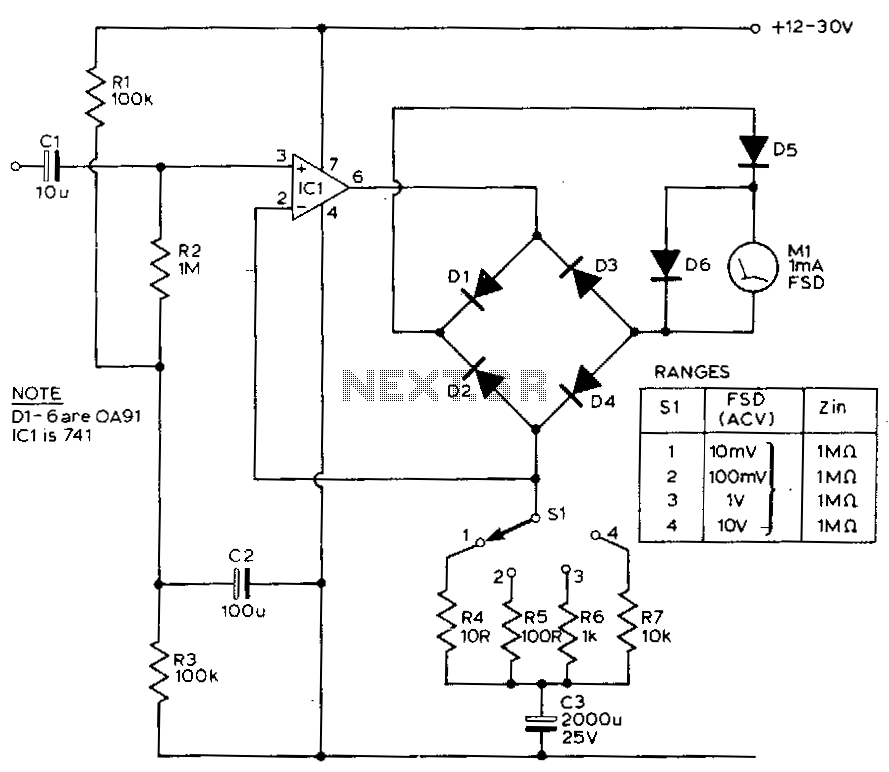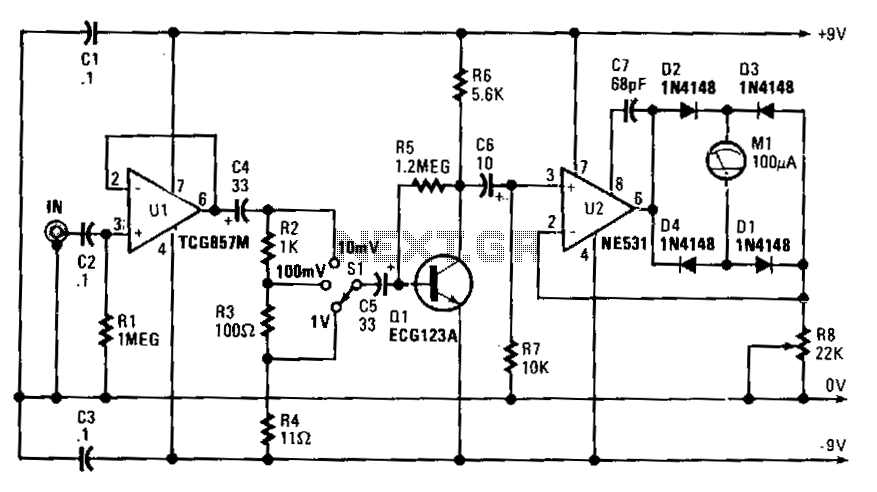
Audio-millivoltmeter

This circuit exhibits a flat frequency response from 8 Hz to 50 kHz, maintaining a -3 dB level at the 10 mV range. Furthermore, while the upper frequency limit remains consistent across less sensitive ranges, the lower frequency limit extends below 1 Hz.
The circuit described is an audio or signal processing system designed to operate effectively across a wide frequency range, making it suitable for various applications in audio engineering, telecommunications, and instrumentation. The flat response from 8 Hz to 50 kHz indicates that the circuit provides consistent gain across this spectrum, which is critical for ensuring that signals are accurately reproduced without coloration or distortion. The -3 dB point at 10 mV suggests that the circuit is optimized for low-level signals, which is often necessary in sensitive audio applications or when interfacing with other electronic components.
The specification of the upper limit remaining unchanged across less sensitive ranges indicates that the circuit is versatile and can handle signals with varying amplitudes without affecting the high-frequency performance. This characteristic is particularly beneficial in applications where signal integrity is paramount, such as in high-fidelity audio systems or precision measurement equipment.
Moreover, the ability to cover frequencies below 1 Hz expands the circuit's usability into the realm of low-frequency applications, such as seismic detection, medical monitoring equipment, or low-frequency audio systems. This extended lower limit allows for the capture of signals that may be critical in certain environments or applications where sub-audible frequencies play a role.
In summary, the circuit's design is focused on providing a reliable and accurate response across a broad frequency range, making it an essential component in various electronic systems that require precise signal processing capabilities.This circuit has a flat response from 8Hz to 50 kHz at -3 db on tbe 10-mV range. The upper limit remains the same on tbe less sensitive ranges, but the lower frequency limit covers under 1 Hz. 🔗 External reference
The circuit described is an audio or signal processing system designed to operate effectively across a wide frequency range, making it suitable for various applications in audio engineering, telecommunications, and instrumentation. The flat response from 8 Hz to 50 kHz indicates that the circuit provides consistent gain across this spectrum, which is critical for ensuring that signals are accurately reproduced without coloration or distortion. The -3 dB point at 10 mV suggests that the circuit is optimized for low-level signals, which is often necessary in sensitive audio applications or when interfacing with other electronic components.
The specification of the upper limit remaining unchanged across less sensitive ranges indicates that the circuit is versatile and can handle signals with varying amplitudes without affecting the high-frequency performance. This characteristic is particularly beneficial in applications where signal integrity is paramount, such as in high-fidelity audio systems or precision measurement equipment.
Moreover, the ability to cover frequencies below 1 Hz expands the circuit's usability into the realm of low-frequency applications, such as seismic detection, medical monitoring equipment, or low-frequency audio systems. This extended lower limit allows for the capture of signals that may be critical in certain environments or applications where sub-audible frequencies play a role.
In summary, the circuit's design is focused on providing a reliable and accurate response across a broad frequency range, making it an essential component in various electronic systems that require precise signal processing capabilities.This circuit has a flat response from 8Hz to 50 kHz at -3 db on tbe 10-mV range. The upper limit remains the same on tbe less sensitive ranges, but the lower frequency limit covers under 1 Hz. 🔗 External reference
